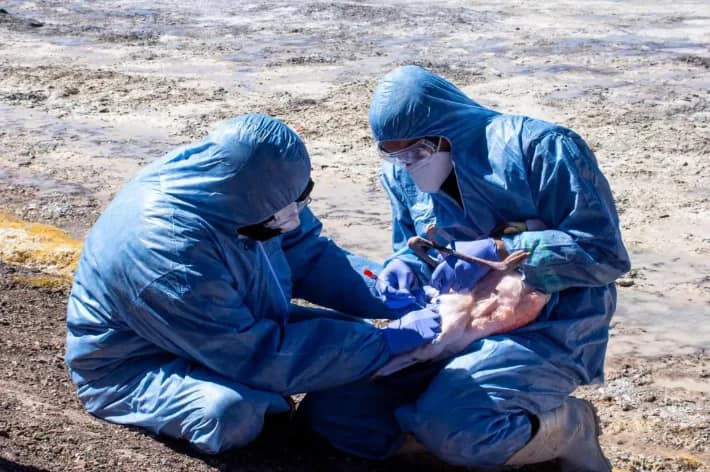Following the deaths of 17 flamingos in Lake Brava days ago, the provincial government and experts provided details at a news conference about research into the birds, local water and land affecting their habitat. Additionally, they reported that this was a “multi-cause event” and that they will continue to conduct research to determine the cause of his death.

At the same time, they reported that there was no possibility of contagion because, through the studies conducted, they ruled out avian influenza or salmonella. It should be remembered that a few days ago these animals without any sign of life appeared in the Laguna Brava Provincial Reserve, mainly in the Golfito area.
Among those present were Santiago Azulay, the province’s Minister of Environment; Franco Alizzi, SENASA representative in the field of animal health; Christian Albretch of the Institute of Environmental Services and Hernán Rojas, technician of the Institute of Environmental Services.
In this sense, Azoulay commented: “We were carrying out field missions that included collecting water, soil and tissue samples from flamingos. One of the ones we captured and released at the time was swabbed and one Autopsies were performed on recently deceased bodies.
“We want to reassure all tourism operators, foreigners and Riojans that we do not have any contagious diseases.” Similarly, he stressed that “there is no avian influenza, salmonella or any other similar diseases.” He also recalled, ” We found approximately 592 flamingos still alive.
During all migrations, animals die from the stress. It’s also clear that about 70% of Lake Brava is frozen, which means less food is available to the birds. This year we have more flamingos, but less water available. “
“No mining activity”
At the same time, regarding the mining work in the area, he made it clear that “we plan to continue research that will help us determine what caused their death. We can rule out the absence of mining activity in the Rioja Mountains, which is where the flamingos die” One of the reasons, but that’s not the case.”
He went on to clarify: “We are able to go with those who the community deems necessary to verify that there is no mining activity in the area because otherwise people will be confused and those who are many kilometers away will believe rumors and facts.” Not true. of. “There is mining activity in the area.”
Research and malnutrition conducted Regarding the autopsies and studies carried out by SENASA, Alizzi explained: “Since last year we have been in a state of health emergency due to the arrival of avian influenza, a disease with a high mortality rate and in It spreads rapidly among birds… leading to 100% death of them, the consequences of which can be transmitted to humans through direct contact.”
Next, he explained: “We went to the area and took cloacal swabs of the fresh carcasses we found and pharyngeal openings of two flamingos that were in a weakened state. We sent them to cloth The final diagnosis was made by the Enos Aires laboratory and the results were negative, and there was no poultry influence and we requested additional virological studies, which were also negative.”
At the same time, he said, “We isolated a fresher body and did an autopsy to find some findings that would give us some indication of pathology. We didn’t find any changes in the organs or tissues, but they did look weak. And there are some problems.” Low muscle index. ”
In the chest, they are in very poor condition, the muscles are atrophied, there is no adipose tissue to act as an energy reserve, and when the adipose tissue is consumed, it starts to consume the muscle. “We are looking for the cause of the bird’s death. We are waiting for other results but there is no final diagnosis yet. We think it is caused by multiple reasons but the lack of available food (microorganisms in the area) is a factor.” , the professional emphasized, mentioning that “we found about 17 dead birds. “
